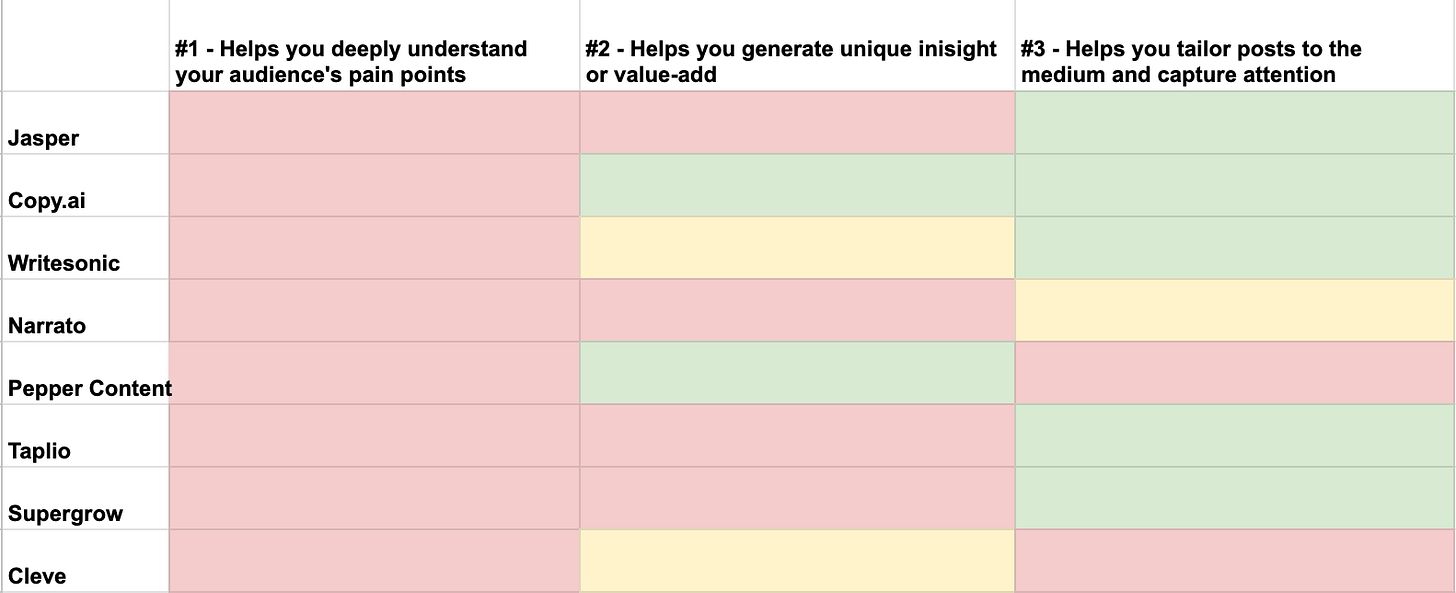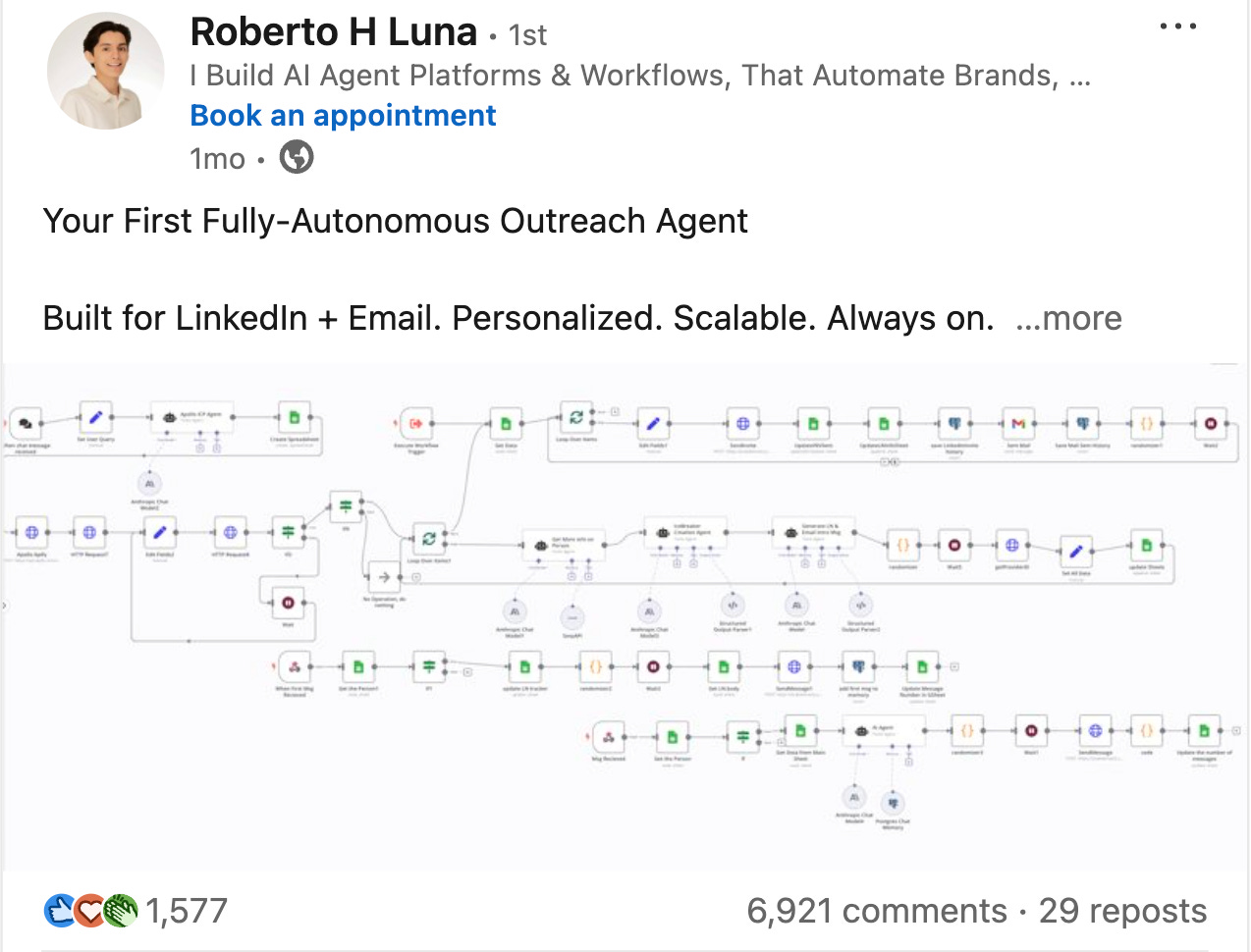Can AI Replace Your LinkedIn Content Strategy? I Spent 100 Hours Finding Out
Where AI helps - and where it fails
At the start of 2025, I noticed a shift: more and more people in my network were posting on LinkedIn, trying to build a personal brand. Many of my founder friends said their investors were pushing them to do it - but almost none of them actually enjoyed it. Most were already thinking about hiring a ghostwriter.
That got me thinking:
What makes a high-quality LinkedIn post?
Could this be scaled using AI?
I started researching, conducted several experiments, and spent a few months ghostwriting for a founder friend. In this article, I break down the key lessons I learned along the way. Anyone not interested in reading the full article can find a summary here.
Background
For the founder friend I worked with (whom I’ll call “Rob” to protect his privacy), we agreed to collaborate for a few months. While we didn’t have any specific goals, our plan was to post three times a week under his LinkedIn account to see if we could, over time, increase the impressions and ‘likes’ on his posts and build an audience. Rob had no immediate use for the audience but desired to build it so that when he did have an offer, he could activate his audience to act on it.
I got raw content for the posts by asking Rob to share past interviews, speeches, or content pieces he had done. I also set up a time to interview him once a week to ask him in-depth questions about his life experiences, beliefs, and perspectives. I recorded these and then, with some custom prompts, used ChatGPT to generate the final LinkedIn posts, which Rob reviewed and ultimately approved.
1). A good post requires a few key building blocks
When I started my research journey, I began by asking, “What are the essential inputs for a high-quality LinkedIn post.” After studying hundreds of high-performing posts, I ultimately concluded that a great post requires three essential building blocks:
#1 - Speaks to a subject your audience cares about.
#2 - Has unique insight or value-add. This could be data-driven, or it could be a personal story or lesson derived from your experience.
#3 - Tailored to the medium and designed to capture attention.
Miss any one of these, and your post is all but guaranteed to fall flat.
2). You have to know your audience deeply to understand what content will resonate
Most tools that claim to help with AI content creation or growing one’s following on LinkedIn, such as Jasper, Narrator, or Supergrow, are generic AI wrappers with a few extra features thrown in.
They opt for a surface-level understanding, enabling you to see what posts are popular in your niche, follow other influencers in your space, or explore trending topics based on the news to delve more deeply.
None of these really help you to truly answer the question, “What are my audience’s pain points, what do they care about, and why?” The only way to gain genuine insight is to have numerous direct conversations with members of your audience (or, ideally, work closely with them for an extended period).
3). There’s a difference between driving engagement and attracting true fans
Working with Rob, we organized our posts into 3 buckets:
#1 - Personal stories and anecdotes
#2 - Hot takes
#3 - Customer success stories
Of the three, the personal stories and anecdotes got far and away the most engagement. The first post we ever did, a personal story about an inspiring manager he once had at work, hit close to 30,000 impressions and 150 ‘likes.’ Another narrative-driven post cracked 100 ‘likes’ and almost 20,000 impressions.
But, our hot takes and customer success stories? They were lucky to hit 5,000 impressions, and some barely cracked double-digit ‘likes.’
When we reviewed the posts that worked, we realized that the engagement was mostly from people in his existing network providing support, reminiscing, or asking questions. We never truly went viral or broke far outside of his immediate network. Our more data-driven posts came across as too sales-y and polished and didn’t really resonate.
It was through these experiences that I began to reconsider “How should we ultimately measure success?” ‘Likes’ and impressions were nice, but if all we were doing was getting a pat on the back for an engaging story, was that really a win? If anything, ‘likes’ and impressions were a weaker signal than re-posts or thoughtful comments.
For most content creators, the long-term goal of building an audience is to drive some reader action. If you seek to rouse people to action, it’s better to have 1,000 true fans than 100,000 lukewarm followers.
4). Unique insights and fresh perspectives can’t be replicated by AI
There is so much noise on LinkedIn, and to stand out, you need to have something original to say. This could be helpful information you share validated by experience (e.g. “We increased our sales close rate by 30% by applying this simple system”), it could be hard-won lessons (e.g. “I failed to get promoted to Manager until I started doing _____”) or it could be the result of deep thinking and introspection (e.g. “Everyone believes _____ - but I’ve come to believe the answer is ____. Here’s why.”).
While you can try to instruct AI to spit out creative takes or to challenge the status quo, that’s really not what it’s designed for. AI is essentially a guessing machine designed to spit back the average of the data it has been trained on. Without having a fresh human touch and perspective, the output is sterile and lacks dynamism.
5). Unique insights and fresh perspectives are the biggest bottleneck and limit scaling
After reflecting on why our posts on hot takes and customer success stories fell flat, I concluded they were too superficial. We were trying to take sound bites and dress them up to sound profound. However, people saw through this, and, lacking a strong narrative or entertainment value, they skipped over it.
Having a unique angle, perspective, or system requires two key elements: experience and reflection. Just having a single, weekly ad hoc interview to flesh out Rob’s unique perspective was insufficient. If founders possess a wealth of knowledge and have already done the hard work of reflecting and generating novel insights (e.g. Paul Graham’s essays), then creating high-quality content from that is a piece of cake. However, absent this, your best bet is to give the founder more opportunities to speak or write about their experiences and beliefs.
One company doing this well is Distro, founded by Alex Lieberman, co-founder of Morning Brew. Distro is an AI content strategist that transforms natural conversations into polished content. The process involves initiating a “studio session” where the founder discusses a topic. Distro then generates an interview plan, conducts the conversation, and produces summaries, key quotes, and multiple drafts for social media posts. It remains to be seen how effective Distro is, but based on my experience, I believe they are on the right track.
6). AI is still a useful research assistant and editor
While the unique insights and fresh perspectives are non-negotiable, and AI is ill-equipped to provide these, it excels in many other areas.
Suppose I want relevant facts and figures for a topic. In that case, I can create an N8N AI agent workflow to ingest numerous reports and YouTube videos and extract the appropriate information. If I want powerful historical examples or stories to support one of my points, ChatGPT Deep Research will provide a wealth of them. If I want a sharper hook or tighter conclusion, AI will serve that up as well.
Conclusion
Ghostwriting LinkedIn content for Rob taught me something essential but straightforward: consistently good content depends less on clever frameworks and more on clarity of thought. The real bottleneck isn’t writing—it’s the work that happens before the writing begins. It’s the reflection, the perspective, the ability to say something useful or interesting based on experience. AI can assist with editing and formatting, but it cannot create depth. To build a lasting audience, ensure you have something interesting to say first.
If you liked this content, please click the <3 button on Substack so I know which content to double down on.
TLDR Summary
This article reflects on the challenges and key lessons learned from ghostwriting LinkedIn content for a founder. It highlights the importance of crafting high-quality, engaging posts that resonate with an audience. While AI can help with editing and research, it can't replace the need for unique insights, personal experiences, and reflection - critical elements for building a lasting and engaged audience on LinkedIn.
Key Steps and Insights
Key Elements of a High-Quality LinkedIn Post
Posts must speak to a subject your audience cares about, offer unique insights, and be designed to capture attention.
Without these elements, posts will likely fall flat.
Understanding Your Audience
To create meaningful content, it's crucial to deeply understand your audience’s pain points and interests.
Tools like Jasper and Narrator help with trending topics, but they don't provide real insights into your audience.
Driving Engagement vs. Building True Fans
Personal stories and anecdotes drove the highest engagement, but ultimately, building a loyal fan base matters more than short-term likes.
Quality engagement from a smaller group of true fans is more valuable than mass appeal.
AI’s Limitations
AI can’t replicate the unique perspectives and insights that come from personal experiences and reflection.
AI’s strength lies in assisting with research, editing, and refining content, but not in creating depth or original ideas.
The Bottleneck in Content Creation
The real challenge in creating impactful content is the reflection and perspective needed before the writing begins.
AI can enhance writing, but it can't provide the deep thinking required for creating meaningful content.
AI as a Research Assistant and Editor
While AI struggles with providing unique insights, it excels as a research assistant and editor.
AI can help pull relevant facts, historical examples, and sharpen hooks, but the essence of the content still relies on human thought and perspective.
Conclusion
To build a successful LinkedIn presence and a loyal audience, the most important factor is not the framework or tools you use - it’s having something interesting and original to say. AI can support content creation by improving writing and offering helpful research, but the real magic happens when your content is driven by deep thought, personal experience, and unique insights.











Do you think it’s possible that people become numb to social media feeds because of a flood of AI generated content? If so, how can you get your ideas out there and find new ways to get people to engage with your content?